
The first HMS Montrose was one of eight Admiralty-type destroyer leaders, sometimes known as the Scott class. They were named after figures from Scottish history; Montrose was named for the Graham Dukes of Montrose. She was built during the First World War, but was completed too late for service then. However, she had a long career in the inter-war years and saw extensive service during the Second World War.
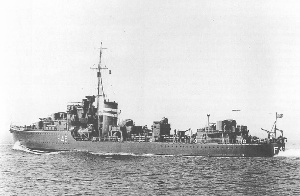
HMS Juno was a J-class destroyer of the Royal Navy laid down by the Fairfield Shipbuilding and Engineering Company, Limited, at Govan in Scotland on 5 October 1937, launched on 8 December 1938 and commissioned on 25 August 1939. Juno participated in the Battle of Calabria in July 1940 and the Battle of Cape Matapan in March 1941.
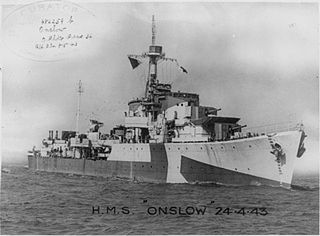
HMS Onslow was an O-class destroyer of the Royal Navy. The O-class were intermediate destroyers, designed before the outbreak of the Second World War to meet likely demands for large number of destroyers. They had a main gun armament of four 4.7 in guns, and had a design speed of 36 kn. Onslow was ordered on 2 October 1939 and was built by John Brown & Company at their Clydebank, Glasgow shipyard, launching on 31 March 1941 and completing on 8 October 1941.

HMS Termagant was a T-class destroyer of the Royal Navy that saw service during the Second World War. She was built by William Denny and Brothers, of Dumbarton and launched on 22 March 1943. She was scrapped in 1965.
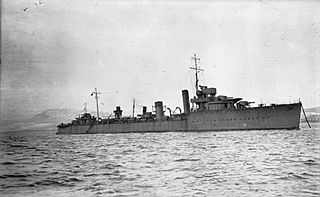
HMS Warwick (D25) was an Admiralty W-class destroyer built in 1917. She saw service in both the First and Second World Wars, before being torpedoed and sunk in February 1944.

HMS Beaufort was a Hunt-class destroyer of the Royal Navy. She was laid down on 17 July 1940 at Cammell Laird, Birkenhead. She was launched on 9 June 1941 and commissioned on 3 November 1941. During the Second World War the ship served in the Mediterranean Sea, escorting convoys and covering landings. She was transferred to the Royal Norwegian Navy in 1952 and scrapped in 1965.

HMS Vanoc was a British V-class destroyer, launched in 1917. The ship saw service in both the First and Second World Wars. During the First World War, Vanoc served as part of two destroyer flotillas, undertaking minelayer and convoy escort roles. In 1919, the destroyer took part in British operations in the Baltic as part of Allied efforts to intervene in the Russian Civil War. During the Second World War, Vanoc was involved in evacuation efforts to remove troops from Norway and France, and was utilised as a convoy escort, protecting convoys from German U-boats. In this role, Vanoc sank a German submarine, German submarine U-100 in March 1941 in the Atlantic, and assisted in the destruction of another, German submarine U-99. Three years later, Vanoc was involved in sinking U-392 in the Straits of Gibraltar in concert with a British frigate and several US anti-submarine aircraft. In January 1945, she was involved in a collision with another Allied vessel off Normandy, before being placed into reserve in June. She was later sold for scrap and was broken up after mid-1946.

HMS Westcott (D47) was a Royal Navy Admiralty W-class destroyer that served in the Second World War. In the Second World War Westcott served in an anti-submarine role and escorted numerous Atlantic and Malta convoys.
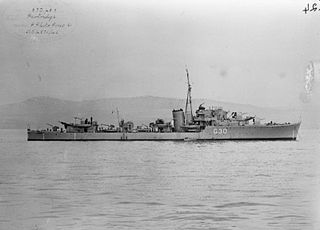
HMS Partridge was a P-class destroyer of the Royal Navy. The O-class were intermediate destroyers, designed before the outbreak of the Second World War to meet likely demands for large number of destroyers. They had a main gun armament of four 4.7 in guns, and had a design speed of 36 kn. Partridge was built by Fairfield Shipbuilding and Engineering Company at their Govan, Scotland shipyard, launching on 5 August 1941 and completing on 22 February 1942.

HMS Valentine was a V and W-class destroyer, built in 1917 for the Royal Navy. She fought in both world wars, serving in several capacities. She was heavily damaged by air attack and beached in 1940 near Terneuzen. Her hulk remained there until it was broken up in 1953.

The fifth HMS Valorous, ex-HMS Montrose, was a V-class flotilla leader of the British Royal Navy that saw service in World War I, the Russian Civil War, and World War II.
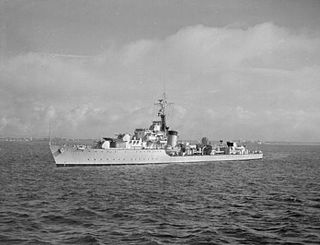
HMS Zephyr was a Z-class destroyer. She was launched on 13 July 1942 at Vickers-Armstrong on Tyneside and commissioned on 6 September 1944. She was 'adopted' by the civil community of Doncaster, replacing the destroyer HMS Lightning, which had originally been adopted during Warship Week in 1942.

HMS Douglas was an Admiralty type flotilla leader of the British Royal Navy. Built by Cammell Laird, Douglas commissioned in 1918, just before the end of the First World War. During the Second World War, Douglas served with Force H out of Gibraltar and as a convoy escort. She was sold for scrap in March 1945.

HMS Oakley was a Type II Hunt-class destroyer of the Royal Navy. She was originally to have been named Tickham, however she was renamed after her sister ship Oakley was transferred to Poland and was renamed ORP Kujawiak (L72). She entered service in May 1943, carrying out convoy escort, patrol and anti-shipping attacks for most of the rest of the Second World War. She was adopted by the Civil community of Leighton Buzzard in Bedforshire as part of Warship Week in 1942. In 1957, she was sold to the West German Navy, serving as a training ship for the German Naval Gunnery school until scrapped in 1972.
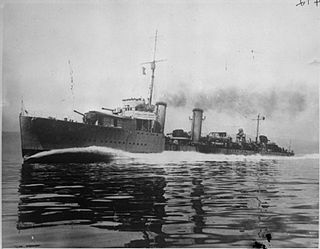
HMS Mackay was an Admiralty type, sometimes known as the Scott class, flotilla leader of the British Royal Navy. Mackay was built by Cammell Laird during the First World War, but was completed too late for service then, commissioning in 1919.

HMS Campbell was an Admiralty type flotilla leader of the British Royal Navy. Built by Cammell Laird, Douglas commissioned in December 1918, just after the end of the First World War. During the Second World War, Campbell mainly served with as a convoy escort, particularly on the East Coast of the United Kingdom. She survived the war, and was sold for scrap in 1947.

HMS Redgauntlet was an R-class destroyer which served with the Royal Navy. Launched on 2 July 1916, the ship operated as part of the Harwich Force during World War I and then, after the War, with the Home Fleet. While taking part in an anti-submarine patrol on 21 May 1917, the ship struck a mine but, although severely damaged, was able to return to England for repairs. Subsequently, the destroyer joined the anti-submarine school at Portsmouth before being sold to be broken up on 16 December 1926 after less than ten years service.

HMS Salmon was an R-class destroyer that served in the Royal Navy during the First World War. The R class were an improvement on the previous M class with geared steam turbines to improve efficiency. Launched by Harland & Wolff at Govan on 7 October 1916, Salmon served with the Fifteenth Destroyer Flotilla of the Grand Fleet. The destroyer escorted convoys between Britain and Scandinavia. At the end of the war, the vessel was allocated to the Home Fleet but was given a reduced crew in 1919 as there was no longer the need for as many active ships in the navy. On 2 December 1933, Salmon was renamed Sable, which ironically had previously been the name of another R-class destroyer that had collided with the vessel in 1917, but only served three years with the new name. The destroyer was sold as part-payment in exchange for the liner Majestic on 28 January 1937 and broken up.

HMS Northesk was an Admiralty M-class destroyer which served in the Royal Navy during the First World War. The M class were an improvement on the previous L-class destroyer, capable of higher speed. The vessel was launched on 6 July 1916 and joined the Grand Fleet. Northesk was involved in escorting convoys, including the first southbound convoy on the coastal route between Lerwick andImmingham in 1917. After the Armistice that marked the end of the First World War, the destroyer joined the Mediterranean Fleet and operated in the area around Sevastopol, including assisting in the evacuation of the Crimea in 1919. Soon afterwards, on 9 May 1921, Northesk was decommissioned and sold to be broken up.

HMS Opportune was an Admiralty M-class destroyer which served in the Royal Navy during the First World War. The M class were an improvement on the previous L-class, capable of higher speed. The vessel was launched on 20 November 1915 and joined the Grand Fleet. Opportune spent much of the war involved in anti-submarine warfare. The ship took part in large patrols to seek out submarines which involved entire flotillas and also acted as an escort for convoys. After the Armistice that marked the end of the First World War, the destroyer was transferred to Portsmouth and placed in reserve. After a brief spell as a remote controlled target to test how warships responded to attacks by aircraft, Opportune was decommissioned and, on 7 December 1923, sold to be broken up.





















